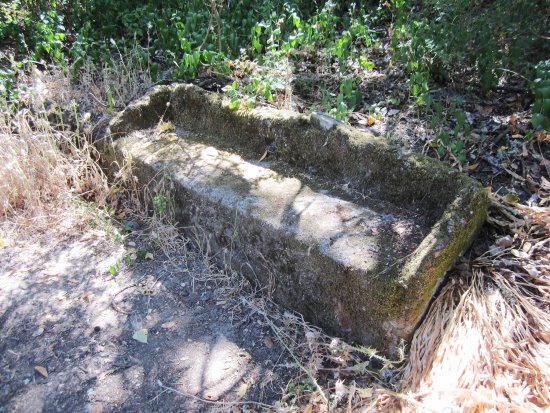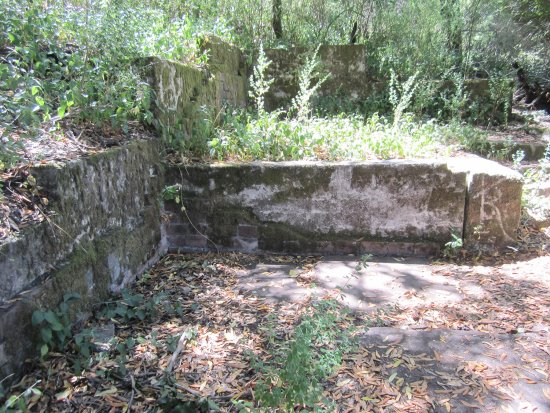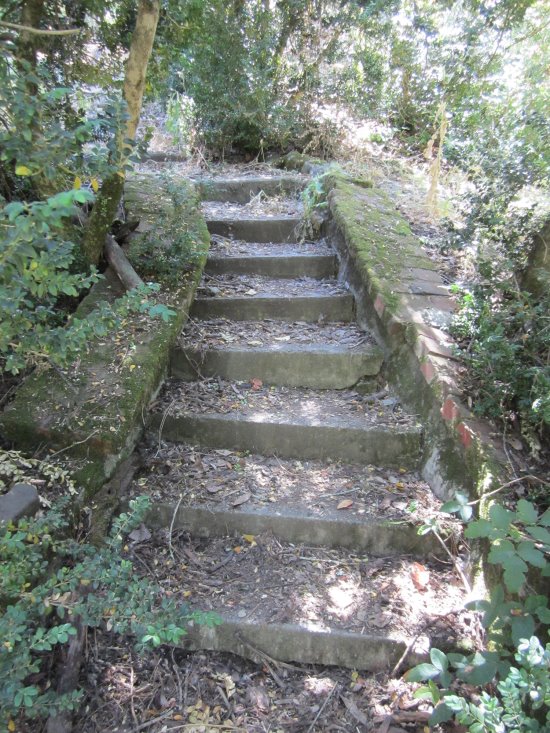 | | | Cement bench Photo Vera Kochan | | | | | | Subdivision No. 3, also known as Valle Vista, came to fruition in 1914, when the Moraga Land Company began selling 98 lots to anyone interested in building homes just beyond Canyon Bridge.
 The new property owners individually contracted with local carpenters to create their dream homes, while Valle Vista's water supply was piped in from a spring that was located near the still standing Joaquin Moraga Adobe in Orinda. The water was basically rationed and restricted - and residents never knew when their particular supply might be cut off.
The new property owners individually contracted with local carpenters to create their dream homes, while Valle Vista's water supply was piped in from a spring that was located near the still standing Joaquin Moraga Adobe in Orinda. The water was basically rationed and restricted - and residents never knew when their particular supply might be cut off.
 Children went to school at Willow Spring School, which was built on land donated by the Moraga Company. The school served Moraga between 1917-1958. Located at 1689 School Street the building is now home to the Willow Spring Community Church. They also attended Valle Vista School, built in 1918, which was renamed Canyon School in 1921.
Children went to school at Willow Spring School, which was built on land donated by the Moraga Company. The school served Moraga between 1917-1958. Located at 1689 School Street the building is now home to the Willow Spring Community Church. They also attended Valle Vista School, built in 1918, which was renamed Canyon School in 1921.
 Although looking at the remote location of Valle Vista by today's standards, one might come to the conclusion that the area was strictly populated by farmers. Not so. The early residents, which numbered 58 families, held a diverse field of occupations besides farming. There were shop keepers/owners, doctors, a dentist, a nurse, a railroad engineer for Southern Pacific, a United States postal employee, a quarry worker, Pacific Gas and Electric employees, an East Bay Water Company inspector, and an auto body mechanic, just to name a few. The Moraga Company maintained several lots throughout Valle Vista in which their employees also lived.
Although looking at the remote location of Valle Vista by today's standards, one might come to the conclusion that the area was strictly populated by farmers. Not so. The early residents, which numbered 58 families, held a diverse field of occupations besides farming. There were shop keepers/owners, doctors, a dentist, a nurse, a railroad engineer for Southern Pacific, a United States postal employee, a quarry worker, Pacific Gas and Electric employees, an East Bay Water Company inspector, and an auto body mechanic, just to name a few. The Moraga Company maintained several lots throughout Valle Vista in which their employees also lived.
 Many residents worked outside of Moraga and often commuted to cities such as Oakland by catching the Oakland-Antioch and Eastern Railroad train at the Valle Vista Station located across the street from the subdivision. On cold, dark mornings men would build a fire near the tracks to keep the commuters warm while waiting for the 6:30 a.m. train. Anyone who worked in San Francisco caught the ferry at Oakland's station to complete their trip. Some residents owned automobiles, but when the rains set in, the roads around town became impassable, and they would instead use a horse and buggy.
Many residents worked outside of Moraga and often commuted to cities such as Oakland by catching the Oakland-Antioch and Eastern Railroad train at the Valle Vista Station located across the street from the subdivision. On cold, dark mornings men would build a fire near the tracks to keep the commuters warm while waiting for the 6:30 a.m. train. Anyone who worked in San Francisco caught the ferry at Oakland's station to complete their trip. Some residents owned automobiles, but when the rains set in, the roads around town became impassable, and they would instead use a horse and buggy.
 People with last names such as Arbuckle, Busch, Dickenson, Dethlefsen, Green, Hespe, Hoyt, Lansdell, McPhee, Oas, Ortett, Potter and Stair were multiple lot owners. Many of the residents in Valle Vista were Scandinavian.
People with last names such as Arbuckle, Busch, Dickenson, Dethlefsen, Green, Hespe, Hoyt, Lansdell, McPhee, Oas, Ortett, Potter and Stair were multiple lot owners. Many of the residents in Valle Vista were Scandinavian.
 A scant eight years later, East Bay Water Company, East Bay Municipal Utility District's predecessor, began buying up property in the low-lying areas of Valle Vista in order to create the Upper San Leandro Reservoir. Residents began selling off their lots in 1922 with the hopes of making a tidy profit from their initial investment of approximately $500 per lot. The first wave of sales ended in 1925, in preparation for the overflow of the Moraga and San Leandro Creeks in 1926, thereby creating the Upper San Leandro Reservoir. The second wave of sales began in 1930, when the new EBMUD wanted to purchase additional land to maintain the reservoir's purity. Single lots began selling for approximately $2,000 depending on acreage. By 1944, EBMUD was buying lots located on the hillsides at prices between $5,000 to $6,000, some even higher depending on their location.
A scant eight years later, East Bay Water Company, East Bay Municipal Utility District's predecessor, began buying up property in the low-lying areas of Valle Vista in order to create the Upper San Leandro Reservoir. Residents began selling off their lots in 1922 with the hopes of making a tidy profit from their initial investment of approximately $500 per lot. The first wave of sales ended in 1925, in preparation for the overflow of the Moraga and San Leandro Creeks in 1926, thereby creating the Upper San Leandro Reservoir. The second wave of sales began in 1930, when the new EBMUD wanted to purchase additional land to maintain the reservoir's purity. Single lots began selling for approximately $2,000 depending on acreage. By 1944, EBMUD was buying lots located on the hillsides at prices between $5,000 to $6,000, some even higher depending on their location.
 According to letters dated 1944, sent from H.J. Wickman, an assistant land agent to J.S. Longwell, a chief engineer and general manager (possibly with EBMUD), many of the remaining homes were substantially large. They contained multiple bedrooms, a kitchen, dining room, living room, bathroom, garage and even a basement. Amenities included, linoleum floors in the kitchen, fireplaces, oak floors, electric hot water heaters, wells and electric pumps. Many properties had decorative gardens with flower beds, fruit and nut trees, even fish ponds.
According to letters dated 1944, sent from H.J. Wickman, an assistant land agent to J.S. Longwell, a chief engineer and general manager (possibly with EBMUD), many of the remaining homes were substantially large. They contained multiple bedrooms, a kitchen, dining room, living room, bathroom, garage and even a basement. Amenities included, linoleum floors in the kitchen, fireplaces, oak floors, electric hot water heaters, wells and electric pumps. Many properties had decorative gardens with flower beds, fruit and nut trees, even fish ponds.
 Miraculously, in the midst of all of the overgrown trees, grass and weeds that have today overtaken most of Valle Vista's Subdivision No. 3, there remain remnants of a foundation - quite possibly the only one left. Located alongside one of the hiking trails, a partially toppled brick structure stands like a sentinel guarding the entrance to a treasure trove of evidence that the community of Valle Vista did indeed exist.
Miraculously, in the midst of all of the overgrown trees, grass and weeds that have today overtaken most of Valle Vista's Subdivision No. 3, there remain remnants of a foundation - quite possibly the only one left. Located alongside one of the hiking trails, a partially toppled brick structure stands like a sentinel guarding the entrance to a treasure trove of evidence that the community of Valle Vista did indeed exist.
 Armed with copies of the original subdivision lot blueprints, lists of property owners and a 1989 sketch of the foundation in question, four "investigators" - one of whom is a historical expert with EBMUD - have come to the conclusion that the mystery foundation was once part of lots 24, 25 and 26. While the lots had gone through several owners, the last one was Charles Dickenson who was negotiating in 1944 to sell to EBMUD.
Armed with copies of the original subdivision lot blueprints, lists of property owners and a 1989 sketch of the foundation in question, four "investigators" - one of whom is a historical expert with EBMUD - have come to the conclusion that the mystery foundation was once part of lots 24, 25 and 26. While the lots had gone through several owners, the last one was Charles Dickenson who was negotiating in 1944 to sell to EBMUD.
 The homestead property was fronted by a low-lying brick/stone wall with a metal gate to the right (a portion of the gate was found in the shrubbery). There are cherry-plum trees on either side of the property and a two-foot tall garden pipe sticking up out of the ground (where a hose could be attached). Cement steps to the right lead up the hill while passing four cement benches on the way up to what remains of the home's brick and cement foundation. Across from the foundation lies what appears to be a very short, round well wall or a fish pond. Leaning alongside this is a discarded metal framework that might have belonged to a fireplace. A long metal pipe leads from the home's foundation back down the hill. This may have been used either to pump water to the house or as a drain pipe.
The homestead property was fronted by a low-lying brick/stone wall with a metal gate to the right (a portion of the gate was found in the shrubbery). There are cherry-plum trees on either side of the property and a two-foot tall garden pipe sticking up out of the ground (where a hose could be attached). Cement steps to the right lead up the hill while passing four cement benches on the way up to what remains of the home's brick and cement foundation. Across from the foundation lies what appears to be a very short, round well wall or a fish pond. Leaning alongside this is a discarded metal framework that might have belonged to a fireplace. A long metal pipe leads from the home's foundation back down the hill. This may have been used either to pump water to the house or as a drain pipe.
 Innumerable hikers pass this foundation on a daily basis, yet very few are aware of its existence beyond the overgrowth up the hill. Perhaps they are intimidated by the fallen trees and forest-like appearance or the idea of woodland creatures roaming and crawling around the remains. Be warned, poison oak does grow within the boundaries.
Innumerable hikers pass this foundation on a daily basis, yet very few are aware of its existence beyond the overgrowth up the hill. Perhaps they are intimidated by the fallen trees and forest-like appearance or the idea of woodland creatures roaming and crawling around the remains. Be warned, poison oak does grow within the boundaries.
 Despite Mother Nature, Father Time and the encroachment of civilization, it's nice to know that a small piece of Valle Vista still makes its mark in Moraga.
Despite Mother Nature, Father Time and the encroachment of civilization, it's nice to know that a small piece of Valle Vista still makes its mark in Moraga.
 Note: Valuable information for this article was retrieved from a letter written to Wilbur Hespe from his mother, Martha Hespe, who were residents of Valle Vista between 1914-1920. Special thanks to Moraga Historical Society President Susan Sperry, Moraga Historical Society Member Sam Sperry, EBMUD Ranger Naturalist II Leatha Harris, Moraga Boy Scout Troop 212's Eagle Scout Mason Fara and Mike Kochan.
Note: Valuable information for this article was retrieved from a letter written to Wilbur Hespe from his mother, Martha Hespe, who were residents of Valle Vista between 1914-1920. Special thanks to Moraga Historical Society President Susan Sperry, Moraga Historical Society Member Sam Sperry, EBMUD Ranger Naturalist II Leatha Harris, Moraga Boy Scout Troop 212's Eagle Scout Mason Fara and Mike Kochan. |


